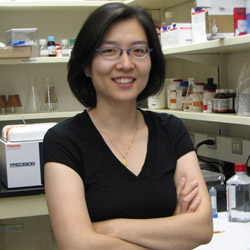| |
| |
| Sohyun Ahn, Ph.D., Investigator |
 |
Dr. Ahn received her Ph.D. in Neuroscience at The Johns Hopkins University School of Medicine in 2000. Her graduate studies in the Laboratory of Dr. David Ginty focused on the role of CREB transcription factor in NGF-dependent gene expression and survival of sympathetic neurons. During her postdoctoral training in Dr. Alexandra Joyner's laboratory at New York University, she addressed the mechanism by which Shh signaling is transduced in vivo using mouse genetics approaches. In 2005, she joined the intramural research program at NICHD, NIH to head Unit on Developmental Neurogenetics. In 2006, She received the Presidential Early Career Awards for Scientists and Engineers, the nation's highest honor for scientists at the onset of their independent careers. Dr. Ahn's laboratory is currently studying the cellular and genetic mechanisms underpinning neural stem cell specification and lineage decisions.
|

|
Staff:
Research Interests:
|
Sonic hedgehog (Shh) is a secreted protein that plays diverse roles in developing embryos and has been also implicated in the ongoing neurogenesis in the postnatal forebrain. She utilized an in vivo genetic fate mapping strategy using Gli1 as a sensitive read-out of Shh activity to systematically mark and follow the fate of Shh-responding cells in mouse (Ahn and Joyner 2004 Cell; Ahn and Joyner 2005 Nature). She demonstrated that only a small initial population of cells that include both quiescent neural stem cells (NSCs) and transit-amplifying (TA) cells responds to Shh in the neurogenic regions, but subsequently expands dramatically to continuously provide new neurons in the forebrain. Her study of the behavior of quiescent NSCs provides the first in vivo evidence that they can self-renew for over a year and generate multiple cell types (Ahn and Joyner 2005 Nature). Based on these results, Dr. Ahn's Unit on Developmental Neurogenetics will continue to investigate the biology of adult neural stem cells: First, the mechanism by which Shh maintains or promotes the survival/proliferation of NSCs: Second, the identity of genes that are specifically expressed in the quiescent NSCs vs. proliferating TA cells: Third, the function of newly generated neurons in the hippocampus in neural circuit formation and plasticity. Combining the sophisticated mouse genetics approaches with molecular and cellular biology techniques in her Unit will provide insights into the cellular and genetic mechanisms underpinning neural stem cell specification and lineage decisions.
|
Selected Recent Publications:
Ahn, S. and Joyner, A.L. (2005) In vivo analysis of Shh-responding quiescent adult neural stem cells., Nature 437 (6) , 894-97.
Ahn, S. and Joyner, A.L. (2004) Dynamic changes in the response of cells to postitive hedgehog-signaling during mouse limb patterning., Cell 16, 118, 505.
Contact Information:
Dr. Sohyun Ahn
Unit on Developmental Neurogenetics
Laboratory of Mammalian Genes and Development, NICHD
9000 Rockville Pike
Building 6B, Room 2B-220
Bethesda, MD 20892-2790
Telephone: (301) 402-2426 (office),
(301) 435-5763 (laboratory),
(301) 402-0543 (fax)
Email: ahnsohyun@mail.nih.gov
|
|















